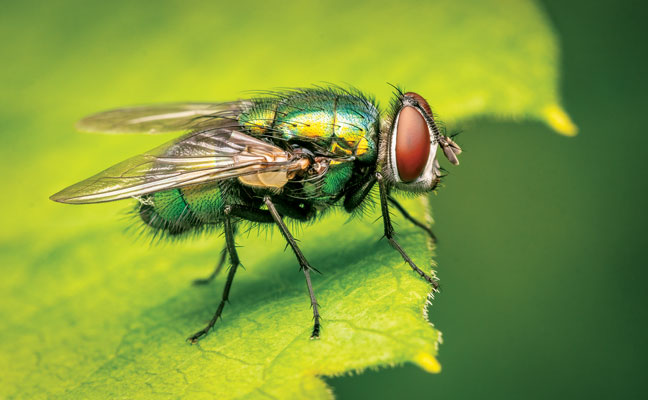
Green bottle flies are considered to be the most encountered calliphorid in the U.S. Photo: Luc Pouliot/iStock / Getty Images Plus/Getty Images
These flies are common in populated areas, and are particularly abundant near such places as slaughterhouses, meat-processing plants and garbage dumps. Flies of this family have feeding habits and mouthparts like house flies (Musca domestica) and are mechanical carriers of disease organisms.
Adults tend to be large in size, with a metallic blue or green color. Eggs usually are laid on meat or dead animals, although they may be placed in decaying vegetable materials when meat is not available. They are frequently found in meat scraps or waste contained in garbage. Garbage cans are the most important sources of bottle flies and blow flies in urban areas. Single cans have produced more than 30,000 flies in a week.
Newly hatched larvae feed for a short time on the surface of the decaying material on which the eggs were laid and then burrow into the less-decayed material underneath. When mature, the larvae leave the food materials and burrow into the ground. They normally overwinter in the soil as full-grown larvae before pupating.
Common calliphorids
Green bottle flies (Lucilia sericata) are the most numerous members of Calliphoridae found in the United States around humans, followed by bronze bottle flies (L. cuprina). These flies develop from egg to adult in nine to 21 days.
Blue bottle flies (Calliphora vomitoria) require 15 or more days to develop from egg to adult. They are common in structures in cool weather, especially if suitable breeding materials are present.
Black blow flies (Phormia regina) are common throughout the United States. They are most abundant in the warm spring months but are also found on warm winter days. Adults are a dark, metallic green color. The life cycle requires 10 to 23 days from egg to adult.
Cluster fly biology and behavior
Cluster flies (Pollenia rudis) are so named because of their habit of forming compact clusters of hibernating individuals, especially in upper rooms, attics and window frames. Adult cluster flies are frequently mistaken for house flies, although they are larger and darker. Unlike house flies, cluster flies fold one wing over the other when at rest. They are also more sluggish in their movements and fly more slowly. The presence of several curly, yellow hairs on the sides of the thorax separates this species from any other North American calliphorid.
Cluster fly eggs are deposited at random in cracks in the ground. Newly hatched larvae enter the bodies of certain earthworms, where they develop for 11 to 14 days. When mature, they leave the body of the earthworm and pupate in the ground. In the fall, cluster fly adults congregate in house voids, particularly in the walls. They can enter through any number of small openings. Therefore, even good screens are often of little value in excluding them.
On warm winter and spring days, they leave these voids in large numbers and are frequently trapped inside the building. They are also frequently found outside buildings on warm, sunny days, particularly on the south and east walls. They are harmless but are a nuisance because of their great numbers. Mixed infestations of cluster flies and face flies (M. autumnalis) are not uncommon.
REFERENCE
Truman’s Scientific Guide to Pest Management Operations, Seventh Edition, available for purchase at MyPMP.net/shop.
Leave A Comment